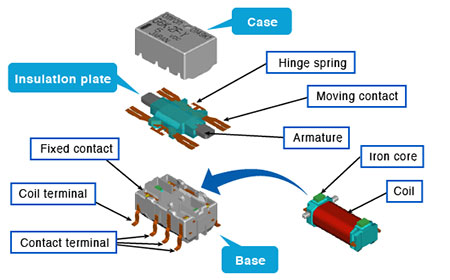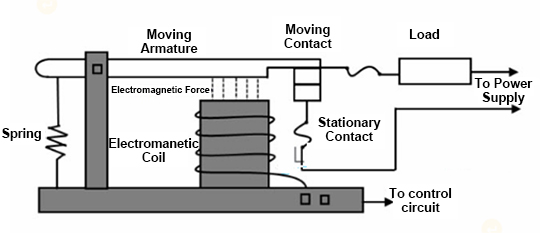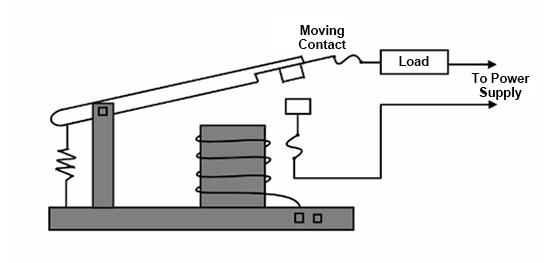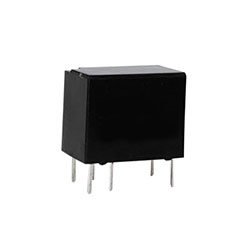What is a Signal Relay?
Relay is a commonly used device in automatic control systems, which is used to connect and disconnect circuits, issue control commands, and reflect equipment status to form automatic control and remote-control circuits. Relay is used for automatic control in various fields. The relay widely used in railway signal technology is called a signal relay (in signal systems, it can be referred to as a relay), which is an important component in railway signaling. It plays an important role both as the core component of relay type signal systems and as an interface component of electronic or computer type signal systems. The reliability of relay operation directly affects the reliability and safety of the signal system.
Internal Composition of Signal Relay
- Coil: The coil is one of the most critical components of a relay, and it is the component that generates the magnetic field of the relay. By powering on and off the coil, the on/off state of the relay can be controlled.
- Iron core: The iron core is an important component of the coil, which can form a magnetic circuit and concentrate electromagnetic induction.
- Contact component: The contact component is the main load part of the relay, including components such as contacts and terminals. The basic working principle of natural electrical appliances is to achieve on-off function through the opening and closing control circuit of contacts.
- Counterweight shrapnel: Counterweight shrapnel is a reference system for controlling relays, and the sensitivity of the contacts to open and close can be adjusted through appropriate counterweights.

Basic Functions of Signal Relay
- It is possible to control the action of a relay with a lower power electrical signal, while the relay controls the action of a higher power executing device. The control objects of railway signals, such as signal machines and switch machines, have high power, so most of them use relay control.
- A complex logic circuit can be composed of relays to check and process various logic conditions, forming a powerful automatic control system. Before the application of computer control technology, relay control circuits were used for station control, section control, and hump shunting control of railway signals. Today, with the widespread application of computer control technology, many circuits still use relay control.
- When the sending end of the control command is far from the executing end, the control signal can be transmitted to the receiving end for amplification, and remote control can be achieved through a relay.
The Working Process of Signal Relay
The following figure illustrates the working process of the relay. For ease of understanding, an attractive electromagnetic relay is provided here. In any type of electromechanical relay, the main components are the coil, armature, and contact. A wire is wound around the magnetic core, forming an electromagnet. When supplying power to the coil, it will be energized and generate an electromagnetic field. An armature is a movable component whose main function is to open or close contacts. It is attached with a spring, so under normal working conditions, the armature returns to its original position. A contact is a conductive component that connects a load and a source circuit.
Power on status
If the coil is powered by a power source, the coil of the relay is energized and generates a magnetic flux proportional to the current flowing through it. This magnetic field attracts the armature to the electromagnet, so the moving and fixed contacts are close to each other, as shown in the following figure. For the NO, NC, and COM terminals (not shown in the figure), when the relay is energized, both NO and COM terminals are in contact, while the NC contacts remain floating. Power off status
Power off status
When there is no power supply to the relay coil, no magnetic flux is generated, so the armature is in a stationary position. Therefore, both contacts remain unchanged and there is a small air gap between these contacts. In other words, the NC and COM contacts come into contact with each other when the coil is powered off.
Advantages of Signal Relay
- High reliability and long service life;
- High switching ability and can control high-power circuits;
- Low power consumption and can save energy;
- Strong anti-interference ability and can work stably in harsh environments;
- Has fast response speed and can achieve fast switching actions;
- Smaller volume and weight, making it easy to install and carry;
- Lower cost and is suitable for large-scale applications.
Application of Signal Relay
Signal relays are used to protect electrical systems and minimize damage to connected equipment in the system due to overcurrent/voltage. Typical application areas of signal relays include:
- Lighting control system
- Telecommunication system

- Industrial process controller
- traffic control
- Motor drive control
- Power system protection system
- computer interface
- automobile
- Household appliances
Signal relays are an essential component for accurate and reliable signal switching and routing in electronic systems. They come in various specifications to meet specific application needs and can be selected based on factors such as voltage, current, switching speed, and contact configuration. The choice of a signal relay depends on the particular requirements of the application.

